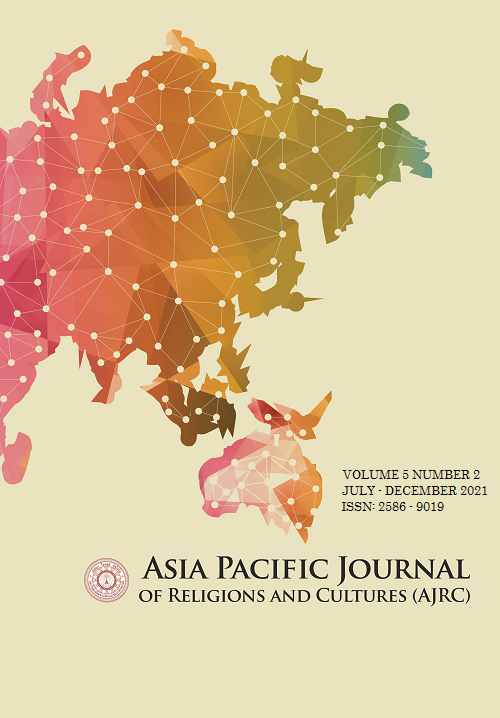A Model Development of the Trisikkhā Principle-Based Learning Behavior Scaling for Trainees Attending the Kai Wai Sai At Mahachulalongkornrajavidyalaya, Phra Nakhon Si Ayutthaya
Main Article Content
Abstract
This research was aimed 1) to study the scale, 2) to model the scale and 3) to appraise the quality of the learning behavior scale based on the Threefold Training (trisikkhā) for the trainees of the Kai Wai Sai Course. This was a mixed-method investigation applying the qualitative scale in order to develop an instrument of a qualitative research. The key informants were the 7 course organizers through in-depth interviews and 360 trainees of the Kai Wai Sai Course in the 2020 Academic Year based on Hair et al (1998) sampling. The instruments in this research comprised 1) the in-depth interview format and 2) the trisikkhā-based learning scale model. Its statistical applications for analyses were descriptive statistics, the Pearson’s Correlation and the second order confirmatory factor analysis. The research results were as follows:
- The guidelines for measuring learning behavior based on the threefold learning principle (trisikkhā) for the trainees of Kai Wai Sai Course, it was found that the training and caretaking of the trainees by the course organizers/ keynote speakers must be friendly and approaching trainees for easing them to embrace and understand their Dhamma training. In the follow-up and evaluation, the camp would measure trainees’ performance with each camp’s indicators through collecting them from the teachers and the chief of the agency. In organizing the training, it should meet the current situation whereas its course development should compile with the current context by exemplifying with the modern and updated contents with national situation of the time so as to more clearly teach Dhamma.
2). The learning behavioral scale based on the threefold learning principle (trisikkhā) for the trainees of Kai Wai Sai Course maintained 3 main components, i.e. 1) the morals learning behavior, 2) the meditative learning behavior, and 3) the intellectual learning behavior. The learning behavior model contained 8 indicators, i.e. 1) good speech, 2) honest actions, 3) honest living, 4) possession of perseverance, 5) possession of conscious self-direction, 6) possession of self-determination, 7) possession of positive attitude and 8) possession of positive thinking.
3) The results of quality examination on the developed learning behavioral scale model based on the threefold learning principle (trisikkhā) for the trainees of Kai Wai Sai Course through applying the second order confirmatory factor analysis (BSMW) were the model was conformed with the empirical data witnessed through the chi-square value (X2 = 21.96, df = 15, p =.1088), which was significantly differed from zero. The Goodness of Fit Index (GFI) was .985, the Adjusted Goodness of Fit Index (AGFI) was .96, and the remainder mean square root index (RMR) was .01 which denoted that the model agreed with the empirical data.
Article Details
References
Abbeduto, L., & Symons, F. (2008). Should schools embrace computers and technology?: Taking sides: Clashing views on controversial issues in educational psychology. New York: McGraw- Hill.
Chayamarit, S. (2021). Human Resource Development to Accommodate the Public and Private Sector Organizations in the Digital Age. Journal of Multidisciplinary in Humanities and Social Sciences, 4(1), 38-50.
Hangsakul, P. G. (2021). Information Technology for Educational Administration. Journal of Educational Management and Research Innovation, 3(1), 1-10.
Intawee, T. (2021). Factors in Affecting Decision Making in Selecting Educational Institutions for Higher. Journal of Educational Innovation and Research, 5(1), 1-14.
Jantrawuddhikorn, S. et al. (2019). Study and Development of a Training Model Based On Threefold Training to Strengthen Ethical Leadership for Executive Officers and Team Leaders in an Organization. Journal of MCU Nakhondhat, 6(10), 5206-5223.
Northouse, P.G. (2010). Leadership Theory and Practice. (5th ed.). California: SAGE Publication.
Office of the Education Council Secretariat. (2005). The National Education Standards. Bangkok: Saha Blog and Printing Limited Partnership.
Pewdum, P. (2021). Professional Learning Community to the Success of the Organization. Journal of Educational Management and Research Innovation, 3(1), 11-18.
Piaget, J. (1972). Development and learning. In Lavattelly, C. S. e Stendler, F. Reading in Child Behavior and Development. New York: Hardcourt Brace Janovich.
Potisuwan, J. (2021). Strategic Leader Behaviors. Journal of Multidisciplinary in Humanities and Social Sciences, 4(1), 135-148.
Santrock. J. W. (2008). Educational Psychology. (3rd ed.). Boston: McGraw-Hill.
Skinner, B.F. (1974). About Behaviorism. New York: Random House.
Urban, K. K. (2005). Assessing creativity: The test for creative thinking-drawing production (TCT-DP). International Education Journal, 6, 272-280.
Wolming, S., & Wikström, C. (2010). The Concept of Validity in Theory and Practice. Assessment in Education: Principles, Policy & Practice, 17(2), 117-132. https://doi.org/10.1080/09695941003693856
Yukl, G. (2010). Leadership in Organization. New Jersey: Prentice-Hall.

